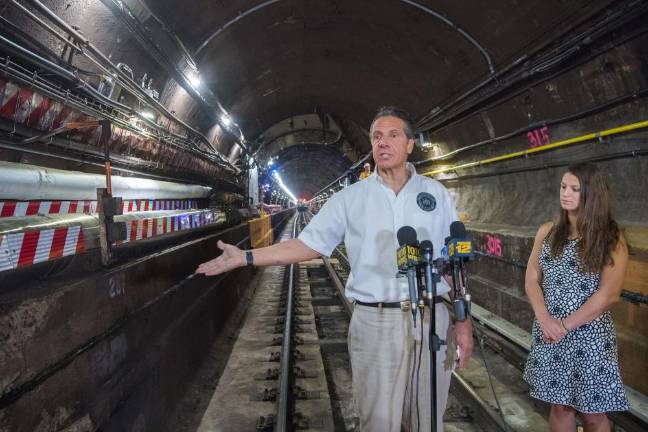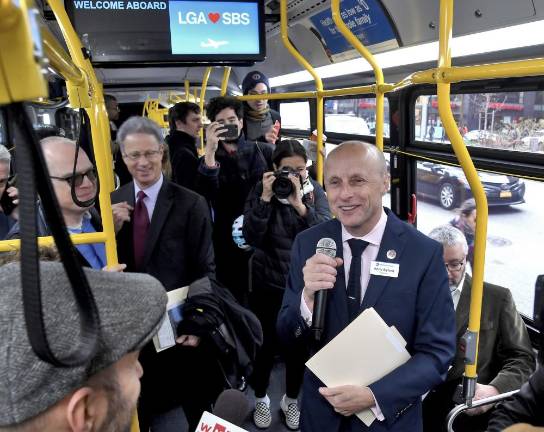Once upon a time in the Great City, Hugh L. Carey, one of New York’s best modern governors, and certainly its most underrated, pledged not to raise the 50 cent fare on the subways and buses. Swiftly, the man Carey had picked to chair the system, Richard Ravitch, contradicted him.
The fare, Ravitch explained, was the difference between how much money was needed to properly maintain and operate the system and how much the state, the city and others put in. Math, in other words, not politics.
Afterward, Carey, raised in the gentle arts of Brooklyn politics, summoned Ravitch to dinner at one of the Governor’s favorite midtown watering holes. In the hardball of New York, the menu would be expected to include a dressing down. Which is why to this day Ravitch loves to repeat what the governor actually said next: “Dick, thanks for getting me off the hook. Don’t pay any attention to what I say.”
That was then.
This is now. “Train Daddy” Andy Byford came and went faster than a speeding A train, the casualty of Governor Cuomo’s penchant to “micro-manage” a system he is bound by state law to keep his hands off of.
Byford’s keep-calm-and-carry-on demeanor had been a tonic for stressed New Yorkers, who sometimes seem to believe an argument is the same as a solution. Yet, by the end, Byford had himself mastered New York’s gravity-knife discourse, explaining he quit because a Cuomo-prompted reorganization had left him with an “important, but reduced, service delivery role” that others could just as well handle.
Clash of Civilizations
Hand wringing ensued. Instead of great talent being lured to the Great City, Byford – being not from Ohio, but England by way of London, Sydney and Toronto – had been driven away. Indeed, he had made it everywhere, but still couldn’t make it here.
This clash of civilizations between the pugilist from Queens and the station master from Plymouth is more than a personality conflict. This is the resurfacing of one of New York’s longest running political questions: Who runs the transit system?
For half a century the consensus answer (as well as the legal one) has been an organization called the Metropolitan Transportation Authority. Sprawling from the Hudson river to Montauk, the agency was the solution to several challenges, all related not to whose hand was on the throttle, but to whose hand was on the checkbook.
First, by creating the MTA, Nelson A. Rockefeller wrested control of the toll revenue from the bridges and tunnels that Robert Moses had built during his long tenure as New York’s great proponent of motoring.
Second, by taking over both the bankrupt commuter railroads and the long past bankrupt city subways and buses, it created a network of service that covered a majority of the state’s legislative districts (which in those days also meant, crucially, city Democrats who ran the Assembly and suburban Republicans who held majority in the State Senate).
The MTA was a rebuke to Moses’ devotion to car culture, which in any case was already fraying by the 1968 founding of the MTA. But in another way it was a monument to his realization that toll and fare revenue is a source of power and a vital tool for raising construction capital. To this day, bridge and tunnel revenue subsidize the maintenance of the subway system.
Which is part of a third important role played by the MTA. Transit fares and service are just about the most potent political issue a mayor or even a governor grapples with. The MTA was to be an independent voice that could lobby the city and state for the resources needed to maintain and operate the system, and raise the fare to fill the gap, Ravitch explained in an interview.
The Governor's de Facto Takeover
This has tended to work in cycles. The recent service crisis was largely the result of deferred work on tracks, roadbeds, tunnels and, most particularly, antiquated signals. Updating the signal system was Byford’s pet project. When the Governor’s reorganization took it away from him, Byford bolted.
The signals will get fixed, but the MTA itself is becoming the issue. Cuomo has effectively undone state law. He runs the MTA as if it were any other state agency, like the motor vehicles bureau. That was never the idea. “Cuomo has violated the law, unequivocally, violated the law,” said Ravitch. “He has micromanaged the MTA from the second floor [where the governor has his Capitol offices].” For his part, the Governor told the New York Time it was necessary to “blow up the MTA” because it’s management had grown comfortable with “happy talk” instead of effective action.
The governor is unlikely to be led away in handcuffs. But his de facto state takeover is now drawing resistance from city officials who want to “take back” the transit system. The speaker of the City Council, Corey Johnson, is preparing a run for Mayor on restoring city control of transit, which was last run directly by the mayor 29 years before Johnson was born.
“If you had municipal control, there would be one person to point to: the Mayor of the City of New York, who when these things are not going well, could and should be held responsible,” Johnson said in a recent City Journal podcast. “Right now, it is set up to deflect any level of accountability. And the public is confused by the governance structure, that was set up to confuse the public.”
It isn’t historically accurate to say the purpose of the MTA was to confuse the public. But it was envisioned as a kind of political Bus Stop Shelter to insulate leaders from the short term furies of fare increases – thus, a way to help them navigate between the Scylla of higher fares and the Charybdis of poor service wrought by inadequate investment in the system (to invoke one of the elder Governor Cuomo's favorite mythological images).
Hugh Carey understood that, bless him. But maybe our new political world no longer tolerates “don’t pay attention to what I say” politics.
Ravitch sniffs at Mayoral control of transit as “political bull****” But between now and voting in next year’s mayoral election, New Yorkers will have time to discuss this among themselves while stuck on the subway.

